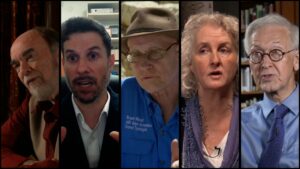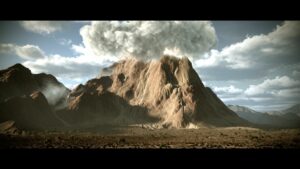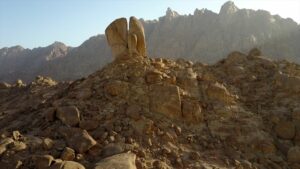
One month prior to the next Indiana Jones movie’s opening nationwide, a film featuring another fedora-wearing investigator of ancient history will play on the big screen.
Tim Mahoney, a filmmaker who has traveled to significant Mideast sites for decades, leads viewers on a journey into biblical history in Journey to Mount Sinai II. The film hits theaters on May 15 and 17 via Fathom Events.
The explorer, who interviews top scholars in his Patterns of Evidence documentary series, shrugs off talk of his expertise. “Oh, I’m just an amateur who makes films,” he said in an interview. ”But I do want to know what the experts think about these issues.”
Mahoney speaks openly of his Christian faith, buthis curiosity and truth-seeking have led him to interview Ph.D.s in archaeology and religion far afield from his beliefs. He says it’s in service of “believers becoming more informed.”
“Many people say there’s no evidence for the Bible,” Mahoney said to me in an interview. “So you start looking at these issues seriously. Some doubt the credibility of the Bible or how God has revealed himself to mankind, which are very significant questions.”
He spoke about why the narrative of his film matters today, and discussed some of the current issues in the field of biblical archaeology. The interview follows, edited for length and clarity.
‘Foundational to Society Today’
This film’s premise is to examine six possible sites of the biblical Mount Sinai. Why is this an important journey for people of faith to go on?
Mahoney: As an observer of history, I am piecing together a story by going on an investigation.
You have to start with a hypothesis — in this series, it’s that the biblical text is a historical record — and it has to be proven by evidence. We start with, what does the Bible say? While there are different interpretations to navigate, that’s how we begin the journey.
This film focuses on the Israelites, who were called to be God’s people. They made a covenant with him, and he had a mission for them. This film is important because it follows them on that Exodus journey, with the events at Mt. Sinai, where the Ten Commandments originated, being so foundational to society today.
When you come into something cold, you have to set the ground rules. What should we look for? What would the pattern of the events and places be? Does the historical and archaeological evidence fit with your theory? The biblical text is our measuring stick.
And I should tell people that you don’t have to watch the first film to get the second one. They do work together but they’re stand-alone films. Audiences will love this one.
This film features leading voices who advocate for each site–some Jewish, some Christian, some secular. What is the benefit to that diversity of input?
The Patterns of Evidence approach is to hear from multiple and opposing points of view. In many documentaries today, they’re trying to give you what feels like a fair and balanced view. But you’re really only hearing the side that somebody wants you to hear. They’re building a case based on an agenda.
I didn’t know at the beginning how valuable it was to consider multiple points of view. But then I got to ask some of these scholars, ‘Well, why don’t you believe in the Bible?’ Or, ‘Why do you think this is the way it is?’ And once you hear the answer more fully, you go: Well, I don’t know that I really buy into that. That it frees up other points of view.
“Journey to Mount Sinai II” features a diversity of esteemed scholars and experts.
All the way back to 2003, I thought about making this film only about one mountain, Jabal Al-Lawz in Saudi Arabia. But we paused on that. And I learned that having a wider lens allows the audience and myself to make more of an informed decision. Now, over two films, Journey to Mount Sinai looks at six mountains.
In recent years, things have changed and access to Saudi Arabia has gotten better. Years ago, two archaeologists I interviewed told me a film like this couldn’t happen. They said: “They’re just not going to allow you to explore, to do anything to affirm biblical history, because of the political issues between Israel and other nations.”
But that history is larger than just Israel. Abraham and these events are recognized and honored by Jews, Christians, and Muslims. With access opening up, this film goes on-site to incredible locations across Egypt, Israel, Saudi Arabia, and elsewhere.
Mistakes Were Made
In archaeology, some have approached it too flippantly and even potentially damaged historic artifacts. What have you learned along the way about the pros and cons of Exodus explorers?
Most of the time, [it’s] amateurs [who] find archaeological sites, according to Jim Phillips of the Chicago Field Museum. It’s because they’re out roaming around and see things. Sites might be uncovered by wind for only a short time. I was told archaeologists found one site and the next year it was gone because the desert basically covered it back up!
In Egypt, when they dig out sites, they have to rent a field because somebody owns it. They get a short window of time to dig it up, find everything, and photograph it. Then they have to put the dirt back over the top of it because it’s somebody’s field.
But you’re alluding to the fact that some Exodus explorers have gone in and dug. One in particular, whom I’ll leave unnamed, went into Saudi Arabia. I don’t know what he was thinking, but you’re not supposed to dig and disrupt sites like that. And then that causes trouble for people in the future who come along.
You didn’t want to name him, but I will mention Ron Wyatt. On one hand, your film lets his family tell their story, but you also present some scholars who dismiss his work. What’s the story that you’re trying to tell here?
It’s complicated, isn’t it? I appreciate what Ron Wyatt was trying to do. On his vacation time, he went to all sorts of places and tried to find things. He got into some amazing, even startling locations in Turkey and Saudi Arabia.
But he got frustrated at the lack of sanctioned access. So he decided to break the rules and head off into places where he wasn’t supposed to be. And he got arrested and they were held captive, because those nations thought he and his team were spies.
He did many rule-breaking things like that. But he really made a big impact. You cannot avoid Ron Wyatt if you’re telling this story. I didn’t feel my obligation was to tell his whole story or point of view. But as an observer painting a portrait of this situation, I went to his family and allowed them to tell me what motivated him. They said he did this work so that more people would know about Jesus.
Some very wise people I’ve interviewed are impressed by the sincerity, passion, and calling of Ron Wyatt. I’ll talk to other people who don’t know him, and they basically thought Ron was just off in his approach. Even myself, I’m sure in making these films, some people wish I made them a little bit differently. But it’s my best attempt.

A dramatic reenactment scene featured in “Journey to Mount Sinai II.”
Mount Sinai in Saudi Arabia
The journey concludes at Jabal Al-Lawz in Saudi Arabia, presented as the candidate with the strongest evidence. What one artifact or discovery there stands out to you the most?
While I’ve known about this mountain for a long time, two areas of evidence are very curiously powerful and interesting to me.
This is sort of a spoiler alert, but the film shows the facts surrounding this issue of water at Jabal Al-Lawz. I was there and I saw this stream that looks like it’s pouring out of the mountain. Certainly the weather conditions and the world have changed a bit, but there’s still water seeping out of that mountain. It looks like they had a reservoir and wells to collect the water. It indicates a large group of people, as we see in Exodus.
Then there’s the question of this massive graveyard being near that site, when there’s no settlement or anything. That connects to the golden calf altar and the killing of 3,000 people when Moses came down from Sinai. The site also has inscriptions that seem to depict golden calf worship, the deity Hathor, and other related imagery.
If we got experts to that site, they’d probably have different opinions. Making way for them to come and perhaps arrive at consensus is likely the next step.

A rock formation near Jabl Al-Lawz, a mountain in Saudi Arabia.
Are experts finally getting in to study this site? And can it be preserved when that region of Saudi Arabia has a significant city being developed?
I can’t talk too much about it, but I do know some experts now are going there and they’re impressed. My understanding is that the nation is going to preserve this mountain site — and even some steps beyond that. I think they’re going to make it a place where religious tourists can come and see.
That’ll be something to talk about in the future, because there are a lot of reasons to believe Jabal Al-Lawz is a very significant site.
History is fascinating and some people say it repeats itself. This journey to Mount Sinai is maybe like a piece of music. It’s a crescendo in the symphony of history. We have to know what happened in the past so we can have a better understanding of the future.
Journey to Mount Sinai II premieres May 15 and 17 in theaters, and is expected to be available for in-home viewing in the following weeks.
A graduate of the University of Colorado, Josh M. Shepherd covers culture, faith, and public policy issues for media outlets including The Stream and The Federalist. Find him on Twitter and Facebook and follow The Stream @Streamdotorg.
React to This Article
What do you think of our coverage in this article? We value your feedback as we continue to grow.

